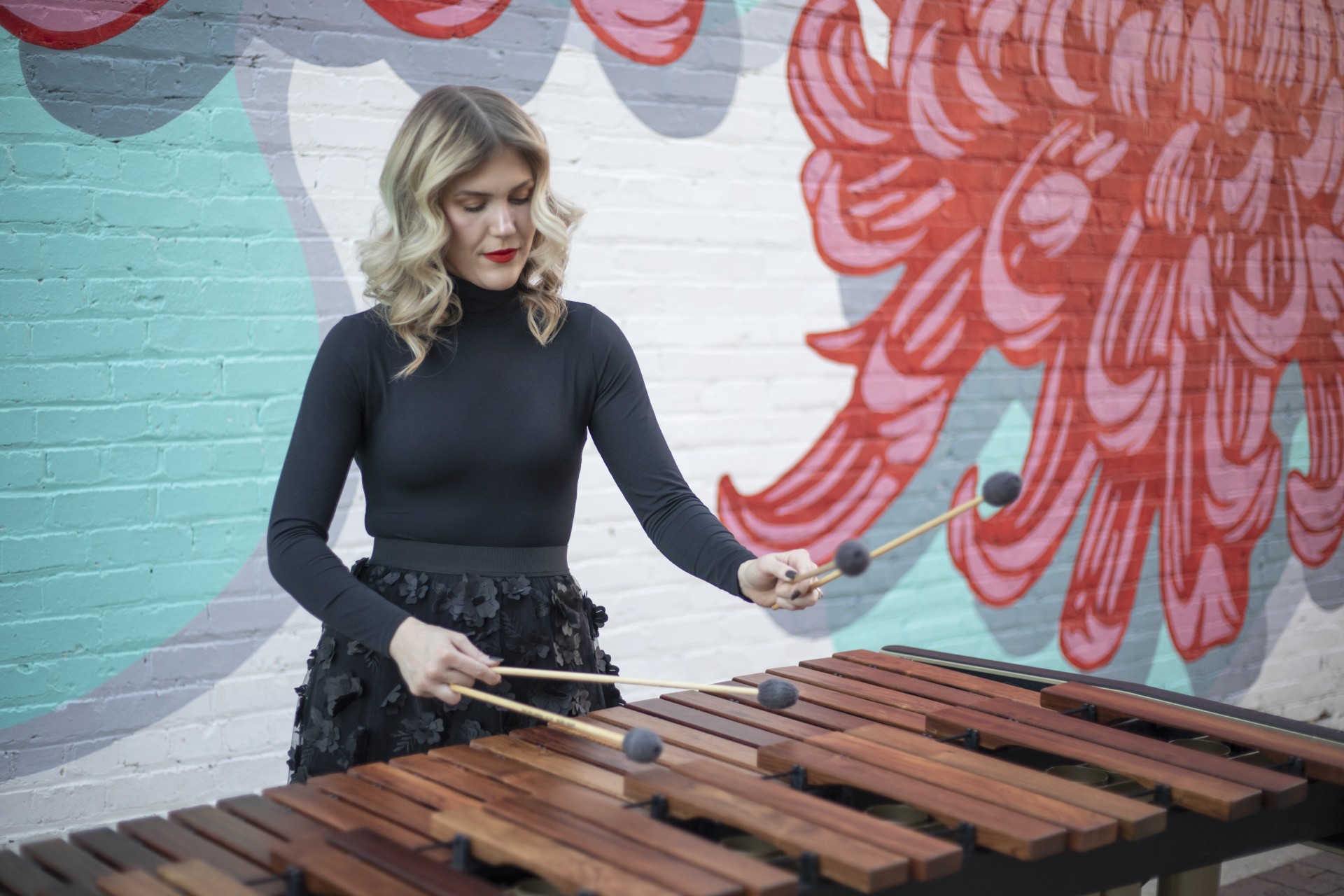Traditionally, the percussionist in a symphony orchestra can be found at the back of the stage, providing support to the violins, violas, cellos, standup basses and wind instruments.
But for the Salina Symphony’s 2024-2025 season opening “Fantastique” concert, percussionist Hannah Applequist will take center stage for a percussion-based concerto called “The Soaring Souls.”
It’s a challenge she finds both daunting and a great honor.
“It’s my first time as a soloist with the Symphony, and I’m still in shock that I’m doing it,” Applequist said. “I thought Yaniv (Segal, conductor and music director of the Salina Symphony) would bring in a guest artist for it, but he said ‘No, I thought you could do this.’ It’s very exciting. I always enjoy a challenge, and I grow when I step out of my comfort zone.”
“The Soaring Souls,” an energetic and lyrical composition written by contemporary composer Paul Dooley and inspired by the tragic love story of Francesca da Rimini, will feature Applequist on a variety of percussion instruments, most predominately the vibraphone and the marimba.
“It’s a great, dramatic piece,” Applequist said. “I view it kind of like a movie, since it’s based on a story from Dante’s ‘Inferno.’”
“The Soaring Souls” will be presented at the Salina Symphony’s “Fantastique” concert, kicking off the Salina Symphony’s 2024-2025 “Kaleidoscope” season. The concert will begin at 4 p.m. on Sun., Oct. 6, at the Stiefel Theatre for the Performing Arts, 151 S. Santa Fe.
In addition to Dooley’s concerto, the Symphony will perform “Bal Masque” by Amy Beach and the highly evocative and expressive “Symphonie Fantastique,” a work written by French composer Hector Berlioz in response to his own experiences of heartbreak, unrequited love and self-destructive passion for a beautiful actress.
Beginning his third year as Salina Symphony music director, Segal said it is important to him that each season tries to build upon the last, both to challenge the musicians and to expose audiences to a variety of classic and contemporary musical experiences.
“My conducting mentors always said that when you practice something, strive to be a little
better than you were before,” Segal said. “We’re building upon what we have, continuing to improve and taking bigger steps than the year before. We’re heading in the right direction and continuing to get better.”
Soaring composer Composer Paul Dooley, a native of Santa Rosa, Calif., is one of the most prolific and performed American composers working today. Through his music, Dooley explores a cross-cultural range of music, dance, art, technology and the interactions between the human and natural worlds.
Dooley’s work has been commissioned and performed by orchestras worldwide, including the Nashville Symphony, Detroit Symphony, Omaha Symphony, Singapore Symphony, Macau Orchestra, Pacific Symphony, Buffalo Philharmonic and the United Nations Chamber Music Society.
In 2013, Dooley joined the music faculty at the University of Michigan, where he created and
directs the Performing Arts Technology department’s annual Computer Music Showcase.
“Paul is another University of Michigan alumni,” said Segal, himself a Michigan alumnus. “I’ve
commissioned pieces from him before.”
“The Soaring Souls,” written in 2022 for solo percussion and orchestra, tells the tragic love story of Francesca da Rimini and Paulo Malatesta in the year 1285, a story famously described in Dante’s “Inferno.” The first movement, “On a Dream,” captures the lovers’ affair in the
overworld, and the second movement, “Storm Eternal,” depicts the lovers in the underworld
after they are condemned to the Second Circle of Hell.
“On a Dream” features lyrical and ethereal music for a reduced orchestral instrumentation of solo vibraphone, clarinets, horns and strings. “Storm Eternal” features darker and more dissonant music for the marimba and full orchestra.
“It’s unusual to think of a percussion concerto, but there’s a lot of expression possible in percussion,” Segal said. “When I saw that Paul had written this concerto, I knew I had the perfect musician for it. I knew it was something we could do with Hannah, who’s a great percussionist.”
Vibraphone and marimba
Applequist said that while she will utilize different percussion instruments, the first movement is performed primarily on the vibraphone, while the second movement features the marimba.
Although they are similar looking instruments (both rather resembling a xylophone), Applequist said they emit two completely different tones.
“The marimba has very large, wooden keys and is traditionally played with mallets, while the vibraphone has metal keys,” she said. “Because of its metal teeth, the vibraphone has a more metallic sound, but it’s a really pretty sound. In this piece, instead of a mallet, a bass bow is used across the vibraphone keys, which makes a really unique sound.”
The marimba, on the other hand, “has a more mellow tone,” Applequist said. “A lot of ringtones use the marimba, and you hear it in a lot of commercials.”
Beach and Berlioz
Amy Beach (1867-1944) was an American composer and pianist, the first successful American female composer of large-scale art music. Her “Gaelic” Symphony, premiered by the Boston Symphony Orchestra in 1896, was the first symphony composed and published by an American woman.
“Bal Masque,” written in 1893 for solo piano and later scored for full orchestra by Beach, is a charming waltz in the salon tradition.
“Amy Beach was a musical prodigy who wrote a lot of choral music, cantatas, a Mass and several orchestral works,” Segal said. “Her piece ‘Bal Masque,’ which translates to ‘masked ball,’ is a light, charming work.”
In contrast, Hector Berlioz used his musical gifts to create a heavily passionate, soaring, epic work of unrequited love in “Symphonie Fantastique.”
The son of a provincial physician who was expected to follow his father into the field of medicine, Berlioz instead took up music. It didn’t take long for his independent mind and refusal to follow traditional rules and formulas to put him in conflict with the conservative musical establishment of Paris.
At the age of 24, Berlioz fell in love with the Irish Shakespearean actress Harriet Smithson and pursued her obsessively. She inspired his first major success, the “Symphonie Fantastique” (1830) in which he uses a recurring “fixed theme” to create an idealized depiction of Harriet throughout each movement.
“Nothing like it had ever really been written like it before,” Segal said. “Berlioz was one of the most colorful composers in classical music and shockingly contemporary. He was the first to create the idea of a fixed theme; music that keeps coming back throughout the piece, like John Williams did with the Imperial March in ‘Star Wars.’”
Pre-concert talk
Segal will host a pre-concert talk beginning at 3 p.m. on the Stiefel Theatre stage. Those attending are requested to enter through the theatre’s main doors, which will open at 2:45 p.m.
The overall title of this Salina Symphony season, “Kaleidoscope,” perfectly illustrates both the
colorfulness of this season’s opening concert and the entire season as a whole, Segal said.
“There’s so much color to downtown now, so we wanted our programs to be colorful too,” he said.
Tickets for the season opening concert are $42 and $45 for adults and $25 for students and may be purchased at the Stiefel Theatre box office, by calling 785-827-1998 or online at www.salinasymphony.org.
For more information about season tickets and the Salina Symphony, call 785-823-8309 or visit the Salina Symphony website.



